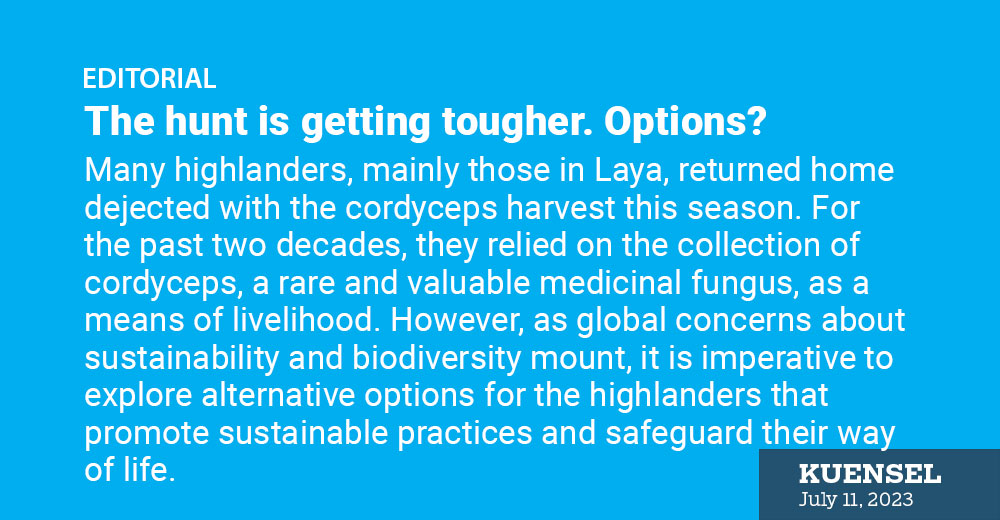Many highlanders, mainly those in Laya, returned home dejected with the cordyceps harvest this season. For the past two decades, they relied on the collection of cordyceps, a rare and valuable medicinal fungus, as a means of livelihood. However, as global concerns about sustainability and biodiversity mount, it is imperative to explore alternative options for the highlanders that promote sustainable practices and safeguard their way of life.
Cordyceps collection has been a significant source of income for Bhutan’s highlanders, but the ecological consequences are becoming increasingly apparent. Records show that Laya has experienced a decline in the abundance and quality of cordyceps in recent years. The amount auctioned at the forest range within the Jigme Dorji National Park showed a decreasing trend—from 55.93kg in 2020 to 38.06kg in 2021.
There is already some tension among stakeholders: highlanders want longer harvest seasons, and conservationists worry about the sustainability of the prized caterpillar.
The decline in production has become a rampant phenomenon across the Himalayan communities in India, Nepal, and China. A research shows significant decline in cordyceps collected— in Nepal and China experienced a substantial drop as much as 70 percent decline.
Fluctuating temperatures and unpredictable weather patterns are believed to have disrupted the growth and development of cordyceps. As mountain areas are expected to experience a further temperature rise, their main source of livelihood is in jeopardy. Experts warn that extreme weather conditions due to a changing climate will adversely impact the highland communities as the warming climate impact the growth of cordyceps
A promising alternative for our highlanders lies in promoting sustainable agriculture practices. The country’s fertile soil and favourable climate make it conducive to cultivating a wide range of crops. By providing training, resources, and incentives for transitioning to sustainable farming methods, we can help highlanders diversify their income streams while mitigating the environmental impact caused by cordyceps collection.
Our breathtaking landscapes and rich cultural heritage present an ideal opportunity for the highlanders to develop and benefit from eco-tourism. By investing in infrastructure and promoting responsible tourism practices, highlanders can capitalise on the growing interest in sustainable travel. There are success stories of community-based homestays, guided nature walks, and cultural exchange programmes. The highlanders possess exceptional skills in traditional crafts and arts, including weaving, woodworking, and painting.
The successful transition to alternative livelihood options requires concerted efforts from many stakeholders, including the local governments in the highlands and international partners. Infrastructure, education, and vocational training to equip highlanders with the necessary skills and knowledge is essential. Sunken bed agriculture in Laya, for instance, is a good example.


